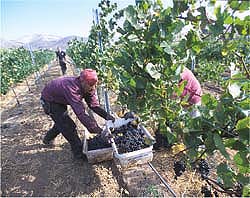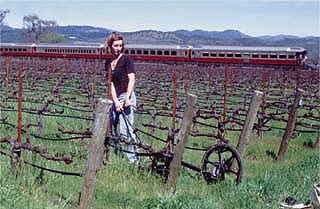All Issues
Science briefs: January-March 2004
Publication Information
California Agriculture 58(1):4-5.
Published January 01, 2004
PDF | Citation | Permissions
Full text
Bush proposes immigration reform
On January 7, President Bush proposed a temporary worker program called Fair and Secure Immigration Reform, “to match willing foreign workers with willing U.S. employers, when no Americans can be found the fill the jobs.” The proposal would grant legal status for 3 years to illegal workers in the United States, allowing them to travel back and forth to their home country without fear of being denied re-entry. “We must make our immigration laws more rational, more humane,” Bush said.
UC Davis agricultural economist Philip Martin says the Bush proposal would allow U.S. employers to validate their past hiring of unauthorized workers and gain easier access to unskilled migrants from abroad, but would not provide migrants with a clear path to immigrant status and citizenship.
A study in this issue of California Agriculture reports that there are currently about 400,000 year-round equivalent jobs in California agriculture, which are filled by an estimated 1.1 million workers ( see page 35 ). Half of these workers are believed to be unauthorized.
“In California, self-employed unauthorized workers, such as those hired in day-labor markets and seasonally in agriculture, are presumably out of luck,” Martin says. “They may find it hard to find employers who can provide credible employment histories.”
Furthermore, Martin says, past experience with temporary worker programs — such as Braceros — in diverse governments and labor markets has shown that “nothing is more permanent than temporary workers.”
Ecosystem approach for Klamath fish
Instead of focusing primarily on how water levels and flows affect endangered and threatened fish in the Klamath Basin, federal agencies charged with protecting the region's fish should pay greater attention to other causes of harm, says an October report from a National Research Council committee.
The committee included UC Davis professors Peter Moyle and Jeffrey Mount. Federal agencies cut off irrigation water to some Klamath Basin farmers in 2001 in an attempt to save endangered fish during a drought, igniting controversy over the Endangered Species Act (see California Agriculture, July-August 2002).
The report covers an array of problems, such as excessive growth of algae and depleted oxygen levels in Upper Klamath Lake, dams that block spawning migrations, competition from hatchery fish, excessive sediment in streams, loss of stream bank vegetation and high water temperatures in the summer. It also emphasizes the need for a multispecies, or ecosystem, approach to management because there are several fish species in the basin that are declining.
“The main solutions for threatened salmon restoration lie in the tributaries, such as the Shasta River,” says Moyle, an expert on native fish. “It once flowed all summer, with crystal-clear cold water, and had huge runs of coho and chinook salmon, and steelhead trout. If you reduced its use for irrigated pasture and alfalfa fields, that would lower its temperature. If you removed Dwinnell Dam, you'd increase access to habitat needed for spawning and for rearing of juveniles. This sort of ecosystem-level approach is what's needed in the Klamath Basin.”
For more information, go to: www.nap.edu/catalog/10838.html .
Feed supplement produces heart-healthy milk
A new cattle-feed supplement that dramatically boosts the content of heart-healthy unsaturated fats in cows' milk has been developed by UC Davis researchers Moshe Rosenberg and Ed DePeters.
Milk, butter and meats contain high levels of saturated fats, which contribute to a higher risk of cardiovascular disease and high cholesterol in humans. Research over the years has focused on how to protect the unsaturated fats in vegetable-based feeds consumed by cows from being broken down by microorganisms in the cow's rumen and converted into saturated fats.
Unlike earlier methods, which involved unsavory chemical additives like formaldehyde and soap, the new supplement relies on proteins that occur naturally in milk and other foods. During feeding trials, the researchers mixed it with the cows' normal feed. Within less than 3 days, they recorded as much as an 800% increase in the proportion of specific unsaturated fatty acids, such as linolenic acid, in the cows' milk. The study involved more than 750 cow-days, with more than 1,500 milk samples analyzed.
Cows eat a variety of plant-based feeds ( see page 54 ), including hay, corn, cotton seed and almond hulls, which contain vegetable oils that are naturally high in unsaturated fats. Announced in November, the new supplement allows these unsaturated fats to pass unmodified through the rumen, the largest of four compartments in the cow's stomach. Eventually, they enter the cow's intestine for digestion, where the unsaturated fatty acids are then available for absorption into the blood stream. Finally, the unsaturated fatty acids are presented to the mammary gland, where the milk is produced. ( See page 59 for a study on the use of tomato pomace in chicken feed.)
Professors Ed DePeters (left) and Moshe Rosenberg offer the feed supplement and hay to cows from the UC Davis dairy herd.
Radar maps soil moisture to create better wine
Winemakers know that soil moisture is key to growing quality wine grapes, but accurately monitoring the soil's water content is a difficult and expensive task. Research led by UC Berkeley scientists is lending a high-tech hand to the fine art of grape growing by using ground penetrating radar, or GPR, to map soil moisture in vineyards.
“By providing detailed information about soil moisture, we can help viticulturists use water more efficiently,” says UC Berkeley professor Yoram Rubin. “This has the potential to improve grape quality while reducing energy and water use.”
GPR technology can also help reduce agricultural pollution and be used to scope out optimum plots of land for new vineyards. Where the soil is spatially uniform, vineyard managers could further refine the practice of matching grape variety to soil conditions. ( See page 44 for research on the use of global positioning systems [GPS] to guide tractors.)
The delicate balance of soil moisture is important in creating smaller berries, which have a higher skin-to-juice ratio. With this higher ratio, the wine grape is more concentrated, ultimately leading to a finer wine.
The researchers use a vacuum cleaner-sized machine to skim the entire surface of the soil, sending electromagnetic pulses about 6 to 9 feet deep. Analysis of the GPR signals has allowed them to accurately estimate soil moisture to within 1% of true values.
For more information, go to: www.coe.berkeley.edu/labnotes/1003/rubin.html .







